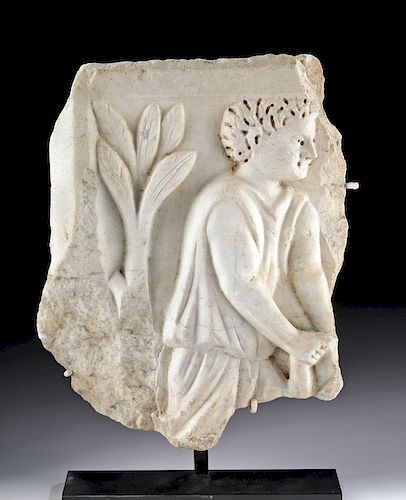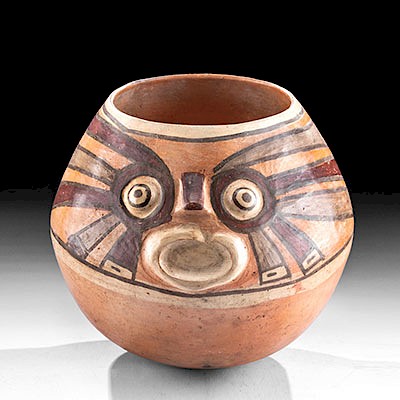Roman Marble Sarcophagus Frieze - Male Youth w/ Grain
Lot 37
About Seller
Artemis Fine Arts
686 S Taylor Ave, Ste 106
Louisville, CO 80027
United States
Selling antiquities, ancient and ethnographic art online since 1993, Artemis Gallery specializes in Classical Antiquities (Egyptian, Greek, Roman, Near Eastern), Asian, Pre-Columbian, African / Tribal / Oceanographic art. Our extensive inventory includes pottery, stone, metal, wood, glass and textil...Read more
Categories
Estimate:
$5,000 - $8,000
Absentee vs Live bid
Two ways to bid:
- Leave a max absentee bid and the platform will bid on your behalf up to your maximum bid during the live auction.
- Bid live during the auction and your bids will be submitted real-time to the auctioneer.
Bid Increments
| Price | Bid Increment |
|---|---|
| $0 | $25 |
| $300 | $50 |
| $1,000 | $100 |
| $2,000 | $250 |
| $5,000 | $500 |
| $10,000 | $1,000 |
| $20,000 | $2,500 |
| $50,000 | $5,000 |
| $100,000 | $10,000 |
| $200,000 | $20,000 |
About Auction
By Artemis Fine Arts
Dec 5, 2019
Set Reminder
2019-12-05 10:00:00
2019-12-05 10:00:00
America/New_York
Bidsquare
Bidsquare : Ancient / Ethnographic - Holiday Edition
https://www.bidsquare.com/auctions/artemis-gallery/ancient-ethnographic---holiday-edition-4710
What to give this holiday season? Ancient & Ethnographic Art of course! Our special Holiday auction features hundreds of unique finds from all over the world. Artemis Fine Arts info@artemisfinearts.com
What to give this holiday season? Ancient & Ethnographic Art of course! Our special Holiday auction features hundreds of unique finds from all over the world. Artemis Fine Arts info@artemisfinearts.com
- Lot Description
Roman, Imperial Period, ca. 1st to 3rd century CE. A finely carved section of a frieze presenting a male youth in profile, wearing draped garments over his chest and hips, with his arms revealed, and his right hand clutching an agricultural tool or walking stick. The young man faces left with a serious expression, as if focused on the task at hand, his determined visage framed by a curly coiffure. In addition, the ancient sculptor delineated the subject's facial features and musculature in a very naturalistic manner, and he appears to be in motion - note how the upper section of his left leg is advanced. Behind him is a leafy crop - perhaps a stalk of grain. The execution of this phytomorphic form, the youth's hair, drapery, as well as his anatomy is meticulous and exemplifies the naturalistic treatment of subjects in the Classical World. Size: 10.25" W x 13.125" H (26 cm x 33.3 cm); 14.875" H (37.8 cm) on included custom stand.
Given the wheat-like form depicting behind the youth, it is possible that he represents Triptolemos who Demeter sent to teach men how to grow grain. This said, on Athenian vases, Triptolemos is usually depicted as a bearded man seated on a winged chariot, and on an original Greek relief found at the sanctuary of Demeter at Eleusis - the famous site of the Eleusian mysteries - as well as Roman copies of this piece, he is shown standing in the nude between Demeter and Persephone.
This Roman sculpture clearly aspired to an earlier Greek tradition that was not interested in veristic representations of age or individualized features. Instead, the emphasis was on an ideal image of perfect anatomy. This said, while not necessarily aiming for realism, the sculptor did strive for and attain naturalism. Note the harmonious proportions of head to body, arm to torso, as well as the meticulous detailing of the hair, eyes, nose, etc. These are all believable to our eyes - although free of any imperfections and hence idealized. While realism depicts the world as it actually is, naturalism in the Classical sense presented a possible world - free of blemishes and full of beauty.
Provenance: ex-William Froelich Collection, New York, USA, 1995; Mr. Froelich had owned the piece in New York since the 1970’s.
All items legal to buy/sell under U.S. Statute covering cultural patrimony Code 2600, CHAPTER 14, and are guaranteed to be as described or your money back.
A Certificate of Authenticity will accompany all winning bids.
We ship worldwide and handle all shipping in-house for your convenience.
#149862A large section from a frieze with losses/abrasions to edges as shown. Surface fissures visible on youth's arm and clothing. Deposits visible in recesses and rougher areas of the periphery. Although a fragment, this piece still presents wonderful imagery attained via skillfully executed techniques.Condition
- Shipping Info
-
All shipping is handled in-house for your convenience. Your invoice from Artemis Gallery will include shipping calculation instructions. If in doubt, please inquire BEFORE bidding for estimated shipping costs for individual items.
-
- Buyer's Premium



 EUR
EUR CAD
CAD AUD
AUD GBP
GBP MXN
MXN HKD
HKD CNY
CNY MYR
MYR SEK
SEK SGD
SGD CHF
CHF THB
THB














